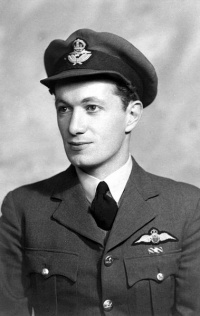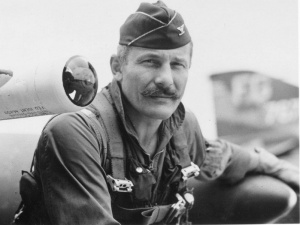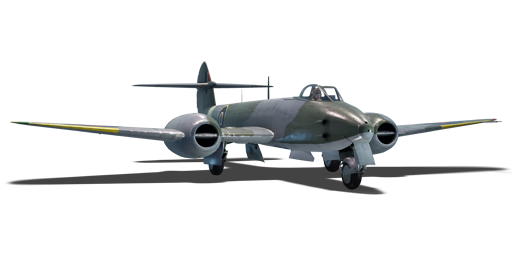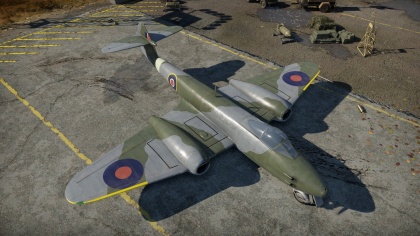Difference between revisions of "Meteor F Mk 3"
m (→General info) |
m (→Details: Updated template to preferred type) |
||
| (One intermediate revision by the same user not shown) | |||
| Line 56: | Line 56: | ||
! Combat !! Take-off !! Landing !! + !! - | ! Combat !! Take-off !! Landing !! + !! - | ||
|- | |- | ||
| − | | {{Specs| | + | | {{Specs|destruction|body}} || {{Specs|destruction|gear}} || 520 || 520|| 290 || ~9 || ~4 |
|- | |- | ||
|} | |} | ||
| Line 79: | Line 79: | ||
! colspan="2" | Empty mass || colspan="2" | Wing loading (full fuel) | ! colspan="2" | Empty mass || colspan="2" | Wing loading (full fuel) | ||
|- | |- | ||
| − | | colspan="2" | Rolls-Royce Derwent 2 || | + | | colspan="2" | Rolls-Royce Derwent 2 || 2 |
| colspan="2" | 4,280 kg || colspan="2" | 159 kg/m<sup>2</sup> | | colspan="2" | 4,280 kg || colspan="2" | 159 kg/m<sup>2</sup> | ||
|- | |- | ||
Revision as of 19:07, 11 February 2020
Contents
| This page is about the British jet fighter Meteor F Mk 3. For other uses, see Meteor (Family). |
Description
The Meteor F Mk 3 is a rank V British jet fighter
with a battle rating of 7.3 (AB/RB) and 7.0 (SB). This aircraft has been in the game since the start of the Open Beta Test prior to Update 1.29.
General info
Flight Performance
| Characteristics | Max Speed (km/h at 6,096 m) |
Max altitude (metres) |
Turn time (seconds) |
Rate of climb (metres/second) |
Take-off run (metres) | |||
|---|---|---|---|---|---|---|---|---|
| AB | RB | AB | RB | AB | RB | |||
| Stock | 718 | 694 | 12500 | 19.6 | 20.0 | 27.7 | 22.5 | 550 |
| Upgraded | 795 | 755 | 19.6 | 20.0 | 27.7 | 22.5 | ||
Details
| Features | |||||
|---|---|---|---|---|---|
| Combat flaps | Take-off flaps | Landing flaps | Air brakes | Arrestor gear | Drogue chute |
| ✓ | ✓ | ✓ | ✓ | X | X |
| Limits | ||||||
|---|---|---|---|---|---|---|
| Wings (km/h) | Gear (km/h) | Flaps (km/h) | Max Static G | |||
| Combat | Take-off | Landing | + | - | ||
| 0 | 390 | 520 | 520 | 290 | ~9 | ~4 |
| Optimal velocities (km/h) | |||
|---|---|---|---|
| Ailerons | Rudder | Elevators | Radiator |
| < 450 | < 600 | < 520 | N/A |
Engine performance
| Engine | Aircraft mass | |||||
|---|---|---|---|---|---|---|
| Engine name | Number | Empty mass | Wing loading (full fuel) | |||
| Rolls-Royce Derwent 2 | 2 | 4,280 kg | 159 kg/m2 | |||
| Engine characteristics | Mass with fuel (no weapons load) | Max Takeoff Weight | ||||
| Weight (each) | Type | 9m fuel | 20m fuel | 31m fuel | ||
| 443 kg | Centrifugal-flow turbojet | 4,651 kg | 5,077 kg | 5,503 kg | 5,820 kg | |
| Maximum engine thrust @ 0 m (RB / SB) | Thrust to weight ratio @ 0 m (109%) | |||||
| Condition | 100% | 109% | 9m fuel | 20m fuel | 31m fuel | MTOW |
| Stationary | 900 kgf | 990 kgf | 0.43 | 0.39 | 0.36 | 0.34 |
| Optimal | 900 kgf (0 km/h) |
990 kgf (0 km/h) |
0.43 | 0.39 | 0.36 | 0.34 |
Survivability and armour
- 38 mm Bulletproof glass in cockpit front.
- 12.7 mm Steel plate behind the pilot.
- 12.7 mm Steel plate in the nose.
- Critical components located at the front and in the wings of the aircraft (fuel, pilot, engine, controls)
Armaments
Offensive armament
The Meteor F Mk 3 is armed with:
- 4 x 20 mm Hispano Mk.V cannon, nose-mounted (200 rpg top, 190 rpg bottom = 780 total)
Usage in the battles
The toughest enemies to fight in the Meteor F Mk 3 are perhaps the Ki-200, Me 163, and Ho 229. These aircraft are faster and have better acceleration.
To combat a Ho 229: the flying wing has a worse roll rate than the Meteor so scissors are the best way to counter them. A split-S or an Immelmann is not recommended as the Ho 229 has better energy retention.
The Me 163B and the Ki-200 are in theory easier to fight since the main priority is to simply survive long enough that they run out of fuel. The Mark 3 has a higher wing lift to mass ratio. Thus, it can barely out-turn the rocket planes (even with their rocket engines enabled), but this is very dangerous and only the better-skilled pilot will come out of a turn fight alive.
If the enemy is smart enough to dive and gather a little more speed for extra manoeuvrability, go up instead and roll over the enemy. If the enemy goes up, go up with it but be prepared for a hammerhead attack. If one does come, roll yourself over to provide the minimum surface area that he can attack and pitch down to the earth (to gather a little more speed for extra manoeuvrability). Continue doing this until the rocket plane gives up or runs out of fuel.
Do not chase the rocket plane directly if it decides to flee, but climb slightly faster than the best rate of climb (approximately 190 knots/350 kmh/220 mph) and if he flies directly overhead for the strike, simply perform a shallow dive and pull a horizontal turn to ruin their approach. Continue doing this until they run out of fuel.
Modules
| Tier | Flight performance | Survivability | Weaponry | ||
|---|---|---|---|---|---|
| I | Fuselage Repair | Radiator | |||
| II | Compressor | Airframe | |||
| III | Wings Repair | Engine | |||
| IV | Engine Injection | Cover | |||
Pros and cons
Pros:
- Good turn rate
- 4 x 20 mm cannons are accurate
- Effective air targets ammo belt
- Decent climb rate and energy retention
- Decent manoeuvrability at low speeds
Cons:
- Low top speed
- Easily rips wings (500 mph+)
- Below average roll rate
- Poor rear cockpit visibility in Sim battles (hurts when performing scissors)
History
Describe the history of the creation and combat usage of the aircraft in more detail than in the introduction. If the historical reference turns out to be too big, take it to a separate article, taking a link to an article about the vehicle and adding a block "/ historical reference" (example: https://wiki.warthunder.com/Name-vehicles/historical reference) and add a link to it here using the main template. Be sure to include links to sources at the end of the article.
In-game description
The Gloster Meteor was the RAF’s first jet powered aircraft, and the only Allied jet to see combat in the Second World War. An all-metal, single-seat fighter with two turbojet engines, it first entered service in 1944. The aircraft's development started in August 1940 and was given Air Ministry approval in November of the same year. The Ministry of Aircraft Production drew up the official F.9/40 specifications for a heavy interceptor fighter to be designated as Type G.41; the first prototype fighter flew on March 5th 1943 at RAF Cranwell. At the beginning of 1944, the aircraft was launched into full-scale production under the designation of Gloster Meteor F.Mk.I (Type G.41A). The type entered service with No 616 Squadron who, after conversion to the Meteor from their Spitfire Mk.VIIs, used the ground breaking fighter to successfully intercept V-1 ‘flying bombs’ which were being launched from bases in occupied Europe to attack targets in England.
The Gloster Meteor F.Mk.III fighter that entered service in August 1944 became the first full-scale production version of the aircraft. The F.Mk.III version was powered by two Rolls-Royce Derwent Mk.I turbojet engines producing 910 kg of thrust. Furthermore, a number of changes were introduced in the design: the dive flaps were improved, the fuel quantity was increased, and the airframe was partially reinforced. Externally, the F.Mk.III differed from the F.Mk.I by its new cockpit canopy, which was not side-opening but sliding.
The fighter's armament consisted of four 20mm British Hispano Mk.II cannons with 200 rounds per gun in the upper pair and 190 rounds per gun in the lower pair.
A 180-gallon (818 L) fuel tank could be suspended under the fuselage. Two 100-gallon (455 L) external fuel tanks could also be mounted under the wing panels. As an experiment, the suspension of two 500-lb (227 kg) or 1,000 (454 kg) bombs or 16 rockets was attempted.
The first F.Mk.III fighters produced in September 1944 had Rolls-Royce Welland engines producing 770 kg of thrust, as the Rolls-Royce Derwents were not yet mass-produced. These aircraft were designated as the G.41C. The 16th and subsequent production aircraft were the first to have standard Derwent Mk.I engines; these were designated as the G.41D. The last 15 production aircraft assembled were the G.41E version, with extended nacelles designed for the subsequent version of the F.Mk.4.
In 1948, two production aircraft were converted to the Gloster (Sea) Meteor F.Mk.3 version for Royal Navy test flights from aircraft carriers. The fighters had their armament removed, a landing hook fitted, and the gear legs reinforced. The Derwent Mk.1 engines were replaced with Derwent Mk.5 models. These aircraft performed 32 landings on board HMS Illustrious.
The Gloster Meteor was the first British production jet fighter and the only Allied jet aircraft to take part in World War II. The first F.Mk.IIIs were delivered to the front at the end of January 1945. Jet aircraft were considered to be secret and, as a result, a great number of limitations were imposed on their combat use. This included a complete withdrawal of permission to operate over German held territory in case the revolutionary technology was captured by the enemy. Meteors did eventually operate out of Belgium as part of the 2nd Tactical Air Force, where they were employed in ground attack and reconnaissance missions.
The total number of F.Mk.III Gloster Meteors built was 210, but service after the end of the Second World War would see further development and operational sorties in combat.
Notable pilots
-
 Top scoring Southern Rhodesian ace pilot John Plagis and highest scoring pilot of Greek origin of WW II. Plagis flew the Meteor for several years after the end of WW II.
Top scoring Southern Rhodesian ace pilot John Plagis and highest scoring pilot of Greek origin of WW II. Plagis flew the Meteor for several years after the end of WW II. -
 In 1948, Robin Olds transferred to England under the USAF/RAF exchange program where he flew the Gloster Meteor jet fighter and commanded the No. 1 Squadron at R.A.F. Tangmere.
In 1948, Robin Olds transferred to England under the USAF/RAF exchange program where he flew the Gloster Meteor jet fighter and commanded the No. 1 Squadron at R.A.F. Tangmere.
Media
An excellent addition to the article will be video guides, as well as screenshots from the game and photos.
Read also
Links to the articles on the War Thunder Wiki that you think will be useful for the reader, for example,
- reference to the series of the aircraft;
- links to approximate analogues of other nations and research trees.
Sources
Paste links to sources and external resources, such as:
- topic on the official game forum;
- page on aircraft encyclopedia;
- other literature.
| Gloster Aircraft Company, Limited | |
|---|---|
| Fighters | Gladiator Mk II · Sea Gladiator Mk I · Gladiator Mk IIS · Tuck's Gladiator Mk II |
| Jet Fighters | Meteor F Mk 3 · Sea Meteor F Mk 3 · Meteor F Mk 4 G.41F · Meteor F Mk 4 G.41G · Meteor F Mk 8 G.41K · Meteor F Mk.8 Reaper |
| Javelin F.(A.W.) Mk.9 | |
| Export | J8A · Iacobi's J8A · ␗Gladiator Mk I · Gladiator Mk IIF |
| Meteor NF.13 · Meteor F.8 | |
| Britain jet aircraft | |
|---|---|
| Blackburn | Buccaneer S.1 · Buccaneer S.2 · Buccaneer S.2B |
| British Aerospace | Harrier GR.7 · Sea Harrier FRS.1 (e) · Sea Harrier FRS.1 |
| British Aircraft Corporation | Strikemaster Mk.88 |
| English Electric | Canberra B Mk 2 · Canberra B (I) Mk 6 · Lightning F.6 · Lightning F.53 |
| Gloster | Meteor F Mk 3 · Sea Meteor F Mk 3 · Meteor F Mk 4 G.41F · Meteor F Mk 4 G.41G · Meteor F Mk 8 G.41K · Meteor F Mk.8 Reaper |
| Javelin F.(A.W.) Mk.9 | |
| de Havilland | Vampire F.B.5 · Venom FB.4 · Sea Venom FAW 20 · Sea Vixen F.A.W. Mk.2 |
| Hawker | Sea Hawk FGA.6 · Hunter F.1 · Hunter F.6 · Hunter FGA.9 · Harrier GR.1 · Harrier GR.3 |
| Panavia | Tornado GR.1 · Tornado F.3 |
| SEPECAT | Jaguar GR.1 · Jaguar GR.1A · Jaguar IS |
| Supermarine | Attacker FB 1 · Attacker FB.2 · Scimitar F Mk.1 · Swift F.1 · Swift F.7 |
| Foreign | Phantom FG.1 (USA) · Phantom FGR.2 (USA) · F-4J(UK) Phantom II (USA) |
| JAS39C (Sweden) | |





